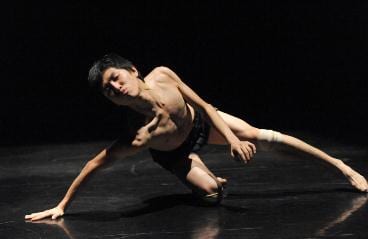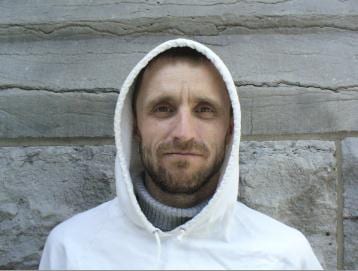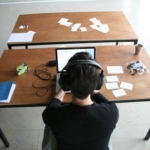
Naishi Wang dances in Etrange, part of Toronto Dance Theatre's Rare Mix program. Credit: Guntar Kravis
Most dance artists are infinitely fascinated with the workings of muscle and bone. But for Jean-Sébastien Lourdais it’s all about organs. His current work, Etrange, explores the body in all its visceral, dripping glory.
Moving beyond torsos and limbs, the piece was created with impulses from the internal systems that keep everything working.
“The Western world has lost its ability to listen to the inside of the body,” the Montreal-based choreographer says. “We want to understand everything mentally, but understanding the body from a kinesthetic perspective bring us into a whole other dimension. With dance we often ignore the fact that all external expressions are connected to internal workings. Our legs and arms move, but it’s the organs that produce the energy that allows movement. ”
Etrange plays as part of Toronto Dance Theatre’s Rare Mix program. First presented as part of this spring’s Four at the Winch festival, the piece returns alongside two of artistic director Christopher House’s past creations (1993’s Four Towers and 1999’s Vena Cava), as well as founding company member Patricia Beatty’s rarely performed 1968 work Against Sleep.
Despite its visceral talk of wetness and organs, Lourdais steers the work away from overt sexuality. Not because he’s afraid of it (his works are often performed nearly nude). Rather, he just doesn’t find it interesting.
“Sexuality and nudity are so in fashion in dance right now,” he says. “The work touches on sex, of course, since we’re dealing with all the energies of the body. But it’s in a very primitive, animalistic kind of way. I’m tired of seeing sensationalism, provocation and violence. I want to see beautiful things onstage.”
In an odd twist, it was exactly this type of work that led Lourdais on his process of creative discovery. His early pieces often had a violent, frenetic quality to the movement, and the pains and injuries sustained while performing led him on the inward journey that now defines his art.
“It was almost like a process of torture to discover my body’s own language,” he says. “But the act of rebuilding and recovering led to the possibility of change. I had to stop scrutinizing the defects of my body and focus on transformation and harmony. My quest now is to continue that process, with more love from the inside to the outside.”
Raised in a small farming community in the Brittany region of France, Lourdais didn’t come to dance easily. Though he’d expressed interest from the age of seven, his working-class parents didn’t have the money for classes or see it as a valid profession. Struggling in school and thought to be dyslexic, he clearly needed a space where he could come into his own. Finally, at the age of 12, his aunt offered to pay for some jazz classes, understanding his need for an outlet.
Though dance was little more than a hobby for the early part of his life, everything changed at 23 when he packed his bags and bought a one-way ticket to Montreal. Enrolled in the Université du Québec à Montréal’s dance program, he found his footing and finally flourished.
“My strength was always in my body, not with words,” he says. “Dance became a means of expression that allowed me to grow from the inside. It brought awareness and energy in a way that was liberating and transforming. It’s helped me discover so much about myself.”
Etrange
Tues, Nov 6–Sat, Nov 10, 8pm
Fleck Dance Theatre
207 Queen’s Quay W
Vena Cava performed by Toronto Dance Theatre from Toronto Dance Theatre on Vimeo.


 Why you can trust Xtra
Why you can trust Xtra


